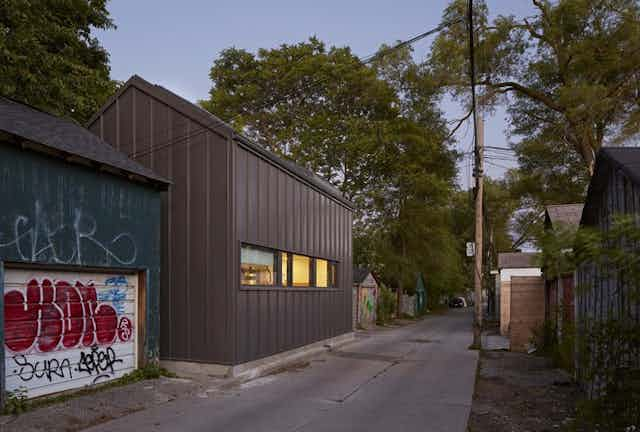Cities across North America are experiencing a housing affordability crisis. Key workers such as teachers, nurses and social workers are being forced out of large cities because they can’t pay rent.
In Toronto, someone making $50,000 can only afford a one-bedroom unit in three of the city’s 140 neighbourhoods, forcing one-in-five renters to live in overcrowded shared apartments. To combat this issue, cities are building taller and taller condo towers to create more units. However, these towers are radically changing the surrounding neighbourhoods without improving affordability.
One solution may be to increase urban density and the number of rental units through laneway housing that maintains the character of a neighbourhood.
Cities are increasingly interested in unlocking the potential of laneways and transforming these underused, historically utilitarian corridors, into thriving public places. Building homes along laneways is a crucial ingredient in this goal.
Our research focuses on locating eligible lots and how to unlock and maximize their potential.
The importance of laneway suites
In contrast to laneway houses, laneway suites are tethered to a separate, primary residence on the same lot. Laneway suites can increase the number of housing units in stable neighbourhoods that are dominated by closely spaced, detached and semi-detached homes.
They take advantage of established infrastructure, such as schools, parks, roadways and transit, and increase sustainability by adding living units into central neighbourhoods. They can also enable multigenerational living by allowing residents to age in place.
Toronto legalized laneway suites in 2018 in an effort to ease the city’s housing crisis. Laneway suites could increase rental stock in established neighbourhoods without affecting their character.

Toronto is not the first city to explore laneway housing. It has been successfully adopted in Vancouver and Calgary, and several cities in the United States. Vancouver has approved over 4,000 laneway suite permits since 2009, while Calgary has similar numbers of backyard suites.
Toronto, by comparison, has lagged behind, issuing only 24 per cent of the permits that Vancouver did in its early years. Why have laneway suites had lower uptake in Toronto despite the steep need for housing?
Barriers to development
Current emergency access requirements are a source of frustration for would-be builders. Toronto grants laneway suite building permits if the plans meet zoning requirements and are in compliance with fire and emergency service (EMS) access requirements.

Our research found these emergency access requirements reduce the total number of laneway suite eligible lots in Toronto to less than 28,000 from 47,000. However, recently adopted updates will increase lot eligibility by 30 per cent to 36,000.
This is a step in the right direction, but still overestimates the total number of eligible lots because of another significant barrier: neighbours.
Where neighbours need to share the side lot space between their homes to meet the required one-metre-wide passage for emergency services, builders need to acquire a Limiting Distance Agreement (LDA). Negotiating this can be a tall order, requiring legal consultation and registration on title, adding risk and uncertainty for the neighbour. An LDA can also benefit neighbours, however, as it could streamline the implementation of their own future laneway suite.

Toronto could decrease the minimum clearance required between houses to 0.81 metres, as other cities have done, to limit LDAs. This is the minimum front door size required by the Ontario Building Code. But this would not prevent unwilling neighbours from halting projects if an LDA is needed.
Most successful laneway suites in Toronto have been completed on narrow lots, seven to nine metres wide, and likely required an LDA. In comparison, the minimum size of an eligible lot in Vancouver is 10.7 metres (32.15 feet) wide, and doesn’t likely require an LDA because the extra width allows for extra clearance.
To mitigate this barrier, Toronto should adopt alternatives to side access by increasing the maximum distance for emergency access along laneways, reducing the required clearance or purchasing smaller fire trucks for denser areas.
Additionally, our research noted that problems can occur with neighbours during the minor variance process if they express NIMBYism. Some people have negative perceptions of renters and their perceived effects on the character of the neighbourhood, causing delays and increasing cost of development.
Public places
Preliminary research suggests laneway suites benefit both homeowners and the neighbourhood by increasing property value and rental income, as well as catalyzing the transformation of laneways into high-quality public places.
The Toronto neighbourhoods with the highest number of eligible lots have aboveaverage walkability scores and relatively underused social infrastructure. Laneways provide connections between public amenities and could promote walking and cycling to schools, libraries, commercial streets and parks through alternative routes with less vehicular traffic. The best way to transform laneways into thriving parts of the public realm is by investing in a mix of uses for housing, work and socialization.

Laneway suites are more than an opportunity to provide housing. They are a first step towards fulfilling laneways’ potential as vibrant and sustainable connections within/between neighbourhoods.
The legacy of laneway suites is to unlock the potential for new, unconventional housing types, such as garden suites, increasing housing units in underused spaces in Toronto’s “Yellowbelt” — zones of residential, detached homes — where there are 10 times more potential lots to add units and address the need for housing.
Michelle Senayah, executive director of the Laneway Project, co-authored this article.

